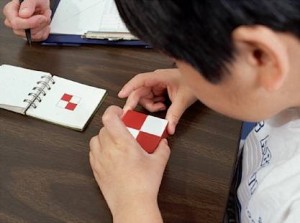Intelligence
Finding Creativity on IQ Tests
Can creativity be measured by existing IQ tests?
Posted July 16, 2011
 IQ tests have received a very large number of criticisms since their inception. One of the main arguments made against the use of IQ tests is that they don't measure creativity. But is this true? Surely creativity involves thoughtful reasoning, divergent production, pattern detection, learning, and other skills tapped into by IQ tests. Indeed, recent research shows that on-the-spot novel problem solving (fluid intelligence) and task switching is related to the ability to come up with unusual uses for an object. So perhaps throwing away IQ tests entirely would be throwing the baby away with the bathwater. Properly administered and interpreted, IQ test scores may shed some light on a person's creative potential.
IQ tests have received a very large number of criticisms since their inception. One of the main arguments made against the use of IQ tests is that they don't measure creativity. But is this true? Surely creativity involves thoughtful reasoning, divergent production, pattern detection, learning, and other skills tapped into by IQ tests. Indeed, recent research shows that on-the-spot novel problem solving (fluid intelligence) and task switching is related to the ability to come up with unusual uses for an object. So perhaps throwing away IQ tests entirely would be throwing the baby away with the bathwater. Properly administered and interpreted, IQ test scores may shed some light on a person's creative potential.
There are lots of reasons why a student may be referred to a school psychologist. Perhaps the student is demonstrating a particular learning disability. Perhaps the student appears right for gifted education. When a student is referred to a school psychologist, the clinician may decide to administer an IQ test to determine the student's pattern of strengths and weaknesses. Whatever the reason for the referral, there is good reason to assess creativity. Creativity is a crucial skills for success and greatness in life, and is often missed just by looking at an individual's global IQ score (which takes the average performance across different subtests).
When administering an IQ test, it's crucial that the psychologist adopt the intelligent testing approach. Coined by Alan S. Kaufman, intelligent testing involves a focus on the person being tested, and how that individuals responds, or why that individuals responds in a certain manner, in addition to how well they respond. The psychologist can help the child or adult being evaluated by observing and interpreting a wide range of behaviors, making inferences about observed problem-solving strategies, and interpreting the test profile within the context of pertinent background information about the person, clinical behaviors observed during the evaluation, and the latest theories and research in the field of cognitive science and learning theory. The entire assessment process should viewed as an experiment conducted with a sample size of one person. Such testing requires a knowledgeable researcher, and test results are meaningless until the individual's scores are put into context by the examiner.
The test administrator should look way beyond global IQ scores. Many aspects of psychology are brought to bear in the analysis and interpretation of a cluster of scores, and all of this information is added to what is already known about the client before the testing session even begins. The accumulated background information and reasons for referral are all part of what is included in forming conclusions and preparing treatment and remedial suggestions that attempt to answer the referral questions. In sum, during the test selection, administration, and interpretation process, one should use the following: knowledge of intelligence-creativity research, the latest theories of intelligence and creativity, and clinical skills or experience in working with creative individuals.
In extracting information about creativity from performance on an IQ test, these principles are of the utmost of importance. So what can clinicians do when a referral question requires them to find evidence of a person's creative potential from a comprehensive assessment? I teamed up with Alan Kaufman's son James C. Kaufman (who is a superstar in the creativity field) and Elizabeth O. Lichtenberger (a leading assessment specialist) to explore just this question (download full paper here). We believe that a test administrator can use the intelligent testing philosophy to find evidence of creativity within the administered IQ subtests. In particular, we make a few recommendations of how to make use of the already existing individually administered cognitive and achievement batteries to extract information about an individual's creative potential.
Test selection. A number of different cognitive and achievement tests exist. The test administrator should pick and choose subtests from different batteries to come up with the best collection of tests related to creativity. Tests already exist that measure creativity-related processes, including measures of associational fluency (the ability to name as many words as possible that start with a certain sound or category), writing fluency (the ability to write down sentences in response to different demands), written expression (the ability to write a story related to a picture), and more. In our paper, we include a Table that shows tests that already exist along these lines.Some tasks may be able to provide information about other referral questions as well as creativity. Also, creativity can be present in more than one domain (e.g., visual and verbal modalities), so it's important to produce a collection of tests that tap a wide range of ways one can express their creativity.
Background information/history. It's important for the test administrator to collect as much information as possible about the client from the client's parents and teachers. In doing so, the psychologist should ask people who know the client questions about his or her creative thinking. Does he or she come up with multiple solutions to problems at home/school/work? Does the client get answers wrong because they have their own unique way of understanding questions? Does the client struggle on multiple choice tests because he or she deems none of the answers to be good enough (or he or she comes up with alternative responses)? Does the client have trouble focusing at times because he or she is deep in thought or daydreaming?
Behavioral observations. The test administrator should be an astute observer of an individual's problem-solving styles and strategies during assessment. The psychologist should gather information about how and why the person responds in a particular way to items. Does an individual try out many different strategies when solving the same type of problem? Does the individual use a trial-and-error problem solving approach? Does the individual use an organized, systematic problem-solving approach? Does the individual elaborate on responses without prompting? Does the individual get frustrated when a task has a forced response that doesn't allow the individual a chance to be original? Does the individual show signs that he or she prefers less structured tasks? Does the individual respond impulsively? It's important for the test administrator to pay attention to the individual.
Test interpretation. High scores don't necessarily mean high creativity. Each of the subtest scores must be interpreted in the context of the examinee's referral question, background, observed behaviors, and other test results. It must also be kept in mind that actual creative achievement requires not only the ability to produce divergent ideas but also the ability to discern which of the ideas are appropriate to a relevant goal. Knowledge of an individual's unique pattern of strengths and weaknesses can be combined with other information about the person, including their global scores, to make a sensible recommendation that has a focus on improving one's performance, not holding them back.
This is just an excerpt from our paper. If you are interested in exploring this issue further, I highly recommend you read the full paper (here). For more on other issues in the field of intelligence and intelligence testing, check out the following recent resources:
Cambridge Handbook of Intelligence
Intelligent Testing: Integrating Theory and Clinical Practice
© 2011 by Scott Barry Kaufman




